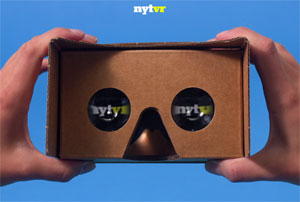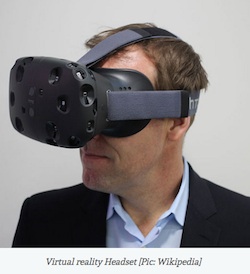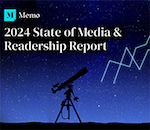 “Virtual Reality,” billed as a startling upgrade to 3D movies and backed by $2 billion from Google and Facebook, could be a new platform for showing products and services to target audiences.
“Virtual Reality,” billed as a startling upgrade to 3D movies and backed by $2 billion from Google and Facebook, could be a new platform for showing products and services to target audiences.
A stereoscopic device is needed. Cost ranges from $23.95 for the Knox V2 viewer to $85 for the Knox Aluminum VR Viewer. Oculus markets a number of products for accessing VR.
The public’s experience with 3D is widening via movies that employ the system and TV sets that have that capability. Prices of 3D TV are still in the thousands of dollars. A 55” Samsung 3D is $2,300. The travel industry has used 3D to promote destinations for at least ten years.
Some warn about the dangers of VR. Its spread could mean “the end of an era of mutual human interaction,” says readnlov.com, a news analysis website. It shows a subject with a large VR device attached to his head.
Samsung warns that use of VR devices could cause motion sickness and nausea, seizures, loss of awareness and eye strain. It says no one under the age of 13 should use the device.
Whether they are a danger to the brain is an open issue.
Electromagnetic Radiation Poses Danger
|
|
|
|
Cell phones, cell towers, microwave ovens, wi-fi systems, laptops and other computers, which emit electromagnetic radiation, are known to cause certain types of cancers.
France does not allow cell phones without headsets or ear pieces that keep the phones away from the head. Cellphones cannot be advertised to those under 14.
Prof. Joel Moskowitz of the University of California at Berkeley says heavy cell phone use for a decade or longer “increases brain tumor risk by at least 30%.” Teenagers and children who use cell phones heavily have five times the rate of brain cancers, said a Feb. 24, 2014 report by Mark DeNicola of Collective Evolution. Cindy Sage of Sage EMF (electromagnetic fields) Design, Santa Barbara, Calif., also warns of the dangers of EMF.
Using a cell phone close to your head is the equivalent of sticking your head in an operating microwave oven, say scientists. Stay at least ten feet away from an operating microwave oven and hold cell phones at least an inch from your ear, they advise. Use a regular phone or the "speaker" option, they advise. Wired connections from the cell phone to ears are dangerous, says RFSafe.
Putting cellphones in airplane mode or turning them off completely eliminates the radiation hazard and also saves the battery.
RFSafe sells a safety kit for Apple's iPhone 6s Plus that has an air tube headset and a flip-case shield to keep radiation away from the body. Cell phones should not be carried close to the body, it says, since tissues and organs lack the bone protection provided by the skull. Children are especially susceptible to cell phone radiation damage.
Don't Carry in Pockets, Says Apple
Apple, in small type as part of instructions for iPhones, says they are not to be carried in pockets. An extensive discussion of cell phone dangers was conducted by Drs. Joseoh Mercola and Devra Davis.
VR was heralded in a full page ad Dec. 22 in the New York Times which invited readers to see a demonstration of the technology called “Take Flight.” NYT has partnered with Google to promote VR.
Shown floating in space and above the New York skyline are celebs such as Charlize Theron, Michael Fassbinder, Lily Tomlin, Melissa McCarthy and Bernicio Del Tore.
Some see the NYT’s push for VR as part of its drive to lower the average age of readers. It dropped the bridge column this year after 80 years and the chess column after 52 years. Both are identified with older audiences. The ad column, dropped after 80 years, had hosted many an ad/PR placement. Some industry leaders did not like daily attention on it.
Right Equipment Needed
Needed to access VR are computers with Apple’s iOS 8 mobile operating system which was released 9/17/2014, or a later version, or Google’s Android 4.3, introduced in 2011, or a later version.
“Using VR, you will be able to experience all the dimensions of the space in which the event is happening,” says readnlov.com. “You can even interact with the virtual environment. All you have to do is wear a headset.”
Newly added to the VR experience is the sense of touch. This is made possible by “haptic or kinesthetic technology in which the sense of touch is induced in a user by applying forces and vibrations.” Based on the movements of the user’s had and eyes, the perspective of what is looked at in the virtual world changes.
Personal computers can run VR software when a headset is used with two visuals, one for each eye.
Readnlov worries that advances in technology like VR will create “a lethargic behavior among users as information is consumed in a convenient manner through videos and graphics…the brain is kept from doing any labor such as reading words.”
People could end up in their “own virtual lands” which will eliminate “the connect between human beings,” it adds. It doubts anything can be done to “stop VR from becoming a normalcy.” Readnlov directs readers to a YouTube video titled “Oculus Rift vs. Brain.”
New York Schools Promote Reading
The New York City Dept. of Education’s program called “NYC Reads 365” encourages students to read every day.
“There is a wealth of research supporting daily reading,” says NYC.“The more we read, the more knowledge we have, the more words we gain exposure to, the more our brain exercises, and the more we experience the joy of getting lost in a story. Reading purely for oneself, to encounter new worlds, to learn new information, to be inspired -- this is the path to success in school as in life.”
Alexandra Petri, writing in the April 7, 2014 Washington Post, said “Reading is apparently a habit that can be unlearned, like politeness and having an attention span of more than 15 seconds.”
Our brains have been altered by “skimming and scanning,” she says. “Spend enough time reading tiny pieces of material and you won’t be able to enjoy Herman Hesse, Swiss poet/novelist, any more, even if you would have enjoyed him in the first place…we are making it harder for our brains to read books.




 Trump Media & Technology Group today reported a $58.2M net loss on $4.1M in 2023 revenues, a disclosure that drove its stock price down 22.6 percent to $47.96.
Trump Media & Technology Group today reported a $58.2M net loss on $4.1M in 2023 revenues, a disclosure that drove its stock price down 22.6 percent to $47.96. Barry Pollack, an attorney at Wall Street’s Harris St. Laurent & Wechsler, has registered Julian Assange as a client with the Justice Dept. “out of an abundance of caution.”
Barry Pollack, an attorney at Wall Street’s Harris St. Laurent & Wechsler, has registered Julian Assange as a client with the Justice Dept. “out of an abundance of caution.” Paramount Global to slash 800 jobs in what chief executive Bob Bakish calls part of an effort to “return the company to earnings growth"... Rolling Stone editor-in-chief Noah Shachtman is exiting at the end of the month due to disagreements with chief executive Gus Wenner over the direction the magazine is taking... The New York Times broke the $1 billion barrier in annual revenue from digital subscriptions in 2023... Press Forward is investing more than $500 million to strengthen local newsrooms.
Paramount Global to slash 800 jobs in what chief executive Bob Bakish calls part of an effort to “return the company to earnings growth"... Rolling Stone editor-in-chief Noah Shachtman is exiting at the end of the month due to disagreements with chief executive Gus Wenner over the direction the magazine is taking... The New York Times broke the $1 billion barrier in annual revenue from digital subscriptions in 2023... Press Forward is investing more than $500 million to strengthen local newsrooms. The majority of news articles are read within the first three days of publication, according to a recent report.
The majority of news articles are read within the first three days of publication, according to a recent report. The Los Angeles Times gives pink slips to 115 people or 20 percent of its newsroom staff... TIME is also laying off about 30 employees, which is approximately 15 percent of its editorial staff... The Baltimore Banner, which was launched by Stewart Bainum in 2022 after he failed to buy the Baltimore Sun, added 500 subscribers per day in the three days following Sinclair Broadcast Group's deal to purchase the Sun.
The Los Angeles Times gives pink slips to 115 people or 20 percent of its newsroom staff... TIME is also laying off about 30 employees, which is approximately 15 percent of its editorial staff... The Baltimore Banner, which was launched by Stewart Bainum in 2022 after he failed to buy the Baltimore Sun, added 500 subscribers per day in the three days following Sinclair Broadcast Group's deal to purchase the Sun.


 Have a comment? Send it to
Have a comment? Send it to 
No comments have been submitted for this story yet.